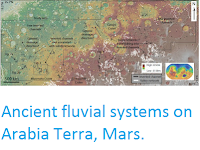During the Late Palaeozoic the supercontinent of Gondwana covered the Southern Polar Region, with the Pole itself moving across Africa and Australia. Evidence for an extensive Southern Polar Glaciation has been found in South Australia, Oman, Ethiopia, Brazil, Egypt, Niger, and Libya. The glaciation seen in Niger and Libya seems extremely likely to continue across the northern part of Chad, which separates the the two regions, however, the remote nature and political instability of this region has prevented exploration by geologists to date.
In a paper published in the journal Geology on 29 November 2017, Daniel Le Heron of the Department of Earth Sciences at Royal Holloway, University of London, describes the results of a study of the topography of the Ennedi-Bourkou Mountains of northern Chad, made using satellite data from Google Earth, which shows the presence of an extensive Carboniferous ice-stream system.
The Ennedi-Bourkou Mountains form the southern margin of the Al Kufrah Basin, which has striated surfaces interpreted as glacial in origin around Jabal Azbah on its eastern margin, in southern Libya. However no such structures have previously been described from the less well explored Chaddian portion of the basin. Le Heron found that the Ennedi-Bourkou Mountains show a series of sinuous belts cutting across a sandstone platform dated to the Carboniferous in the early 1960s (when nobody was looking for evidence of glaciation in the Central Sahara).
Lineament analysis of Google Earth imagery, Ennedi-Bourkou region, northern Chad, illustrating suite of curvilinear features interpreted as mega-scale glacial lineations traversing outcrop belts mapped as Devonian and Carboniferous. Sinuous belts of mega-scale glacial lineations are interpreted as paleo–ice stream pathways; neighbouring regions devoid of these are interpreted as inter-stream areas. The “Mousso” structure is a possible impact crater. Le Heron (2017).
Le Heron was able to detect five main sinuous belts, each 5-12 km in width, which, combined with the interstream areas, cover an area of about 6000 km². These belts can be traced for tens of kilometres, and run approximately north to south.
High-resolution view and interpretation of a paleo–ice stream
track shown in Figure 2. Note deflection of mega-scale glacial lineations
(MSGLs) around hill interpreted as a nunatak. Elevation of
nunatak (1100 m) and of paleo–ice stream track to the west (850 m)
allows maximum thickness of ice to be estimated (i.e. less than 250 m). La Heron (2017).<250 br="" m="">
The belts are cross-cut by more recent features, such as wadis and faults, supporting the interpretation of them as ancient structures, though it is impossible to tell whether they represent a single extended glacial event or a series of glacial cycles.
Series of snapshots from Google Earth imagery of the Ennedi-Bourkou plateaux (Chad) with accompanying interpretations. (A) Interaction of mega-scale glacial lineations (yellow lines) with dipping strata of presumed pre-glacial origin (orange lines), with interpreted glacial erosion surface indicated. Scale bar applies to immediate foreground only. (B) Low-angle perspective of interpreted palaeo–ice stream pathway shown in (A). Note interpreted inter-stream area which is devoid of mega-scale glacial lineations. (C) Mega-scale glacial lineations with evidence of fault offsets (faults in red), underscoring their antiquity (d—drumlins). (D) Development of mega-scale glacial lineations on two plateau levels. La Heron (2017).
The Chadian linear structures appear to cross cut layers of rock similar to those cross-cut by similar structures in Niger, which have been used to date the Niger structures to the Visean Stage, roughly 346.7 to 330.9 million years ago. This suggests an extensive Carboniferous ice sheet in the Sahara, draining to the north. This appears to correlate with an ancient palaeo-shoreline recorded in parts of northern Chad, and dated to about 350 million years ago. The absence of any known fluvial (river-generated) systems associated with this coastline suggests a significant ice-sheet covering the land and calving at the shore margin.
Tentative paleogeographic reconstruction of Visean ice sheet in north-central Africa, incorporating ice flow directions in Aïr Massif of northern Niger with newly documented set of paleo–ice stream pathways in northern Chad. Speculated paleo–ice stream tracks are also shown. Coastline position for Tournasian at 350 Ma. Note close association of paleo–ice stream termini and palaeo-shoreline. La Heron (2017).
See also...
Follow Sciency Thoughts on Facebook.










